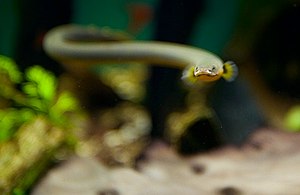Flösselaal
| Flösselaal | ||||||||||||
|---|---|---|---|---|---|---|---|---|---|---|---|---|

Flössel eel ( Erpetoichthys calabaricus ) |
||||||||||||
| Systematics | ||||||||||||
|
||||||||||||
| Scientific name of the genus | ||||||||||||
| Erpetoichthys | ||||||||||||
| Smith , 1865 | ||||||||||||
| Scientific name of the species | ||||||||||||
| Erpetoichthys calabaricus | ||||||||||||
| Smith , 1865 |
The Flössel eel ( Erpetoichthys calabaricus ) is the only species of the genus Erpetoichthys from the family of the Flösselhechte. For many decades it was only known under the generic name " Calamoichthys ". In contrast to the species of the genus of the real Flösselhechte , the Flösseleleal has only 10–12 Flössel and no ventral fins .
description
It is native to western Africa ; the distribution area extends from Benin to Cameroon , whereby it is particularly common in the Niger Delta. The crepuscular and nocturnal animals reach an elongated physique - the length of the animals exceeds their height by 24 times - a maximum length of about 90 cm. Measurements on the Ouémé River in Benin showed lengths of 24.5 to 35.3 cm. The male has twelve to fourteen rays on the dark olive anal fin, which is also thickened at spawning time. The anal fin of the female is pale and has only nine rays. Float eels mostly live in freshwater lakes or rivers, but also go into brackish water. They predatorily feed on smaller animals, especially insects and worms. Finding food is done with the sense of smell, as raft eels see very poorly.
The gills of the raft eels, as with the other raspberry pike, are not sufficient to ensure the animals are supplied with oxygen. The raft eels are therefore additionally dependent on breathing air, whereby the swim bladder of the animals is used as a lung . Therefore, they can leave the water for a few hours. The locomotion is slowly gliding by means of the small pectoral fins, "sideways" (like some snakes) or, more rarely, anguilliform.
Aquarium keeping
The keeping of raft eels in aquariums is quite possible; the animals can occasionally be bought in specialist shops. The pool should be at least one meter long. The temperature of the water should be between 24 and 28 ° C, be slightly acidic (pH 6.5–6.9) and medium hard (around 10 ° dGH). Soft ground made of fine sand should be available, as well as dense planting and hiding places. Float eels are only partially suitable for community tanks, small fish can be eaten. Some animals only eat live food and meat (fish, mussels, crabs, insect larvae, hearts, beef and horse meat). The animals often take high-quality granular feed that sinks to the ground. The basin should be in open places (inflows and outlets) z. B. secured with coarse filter floss to prevent the escape of curious animals.
The species is difficult to breed, but it succeeds under certain conditions.
literature
- Günther Sterba : The world's freshwater fish. 2nd Edition. Urania, Leipzig / Jena / Berlin 1990, ISBN 3-332-00109-4 .
- R. Riehl, HA Baensch: Aquariums Atlas. Mergus Verlag, 1987, ISBN 3-88244-015-5 .
- PA Lalèyè: Length-weight and length-length relationships of fishes from the Ouémé River in Bénin (West Africa). In: Journal of Applied Ichthyology. 22, 2006, pp. 330-333.
Web links
- Erpetoichthys calabaricus on Fishbase.org (English)
- Erpetoichthys calabaricus in the Red List of Threatened Species of the IUCN 2013.2. Posted by: Lalèyè, P., Moelants, T. & Olaosebikan, BD, 2009. Retrieved December 1, 2013.